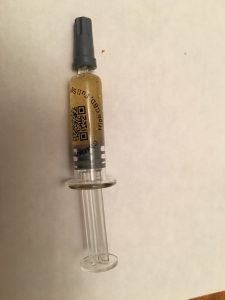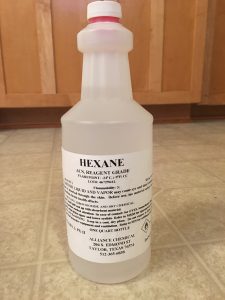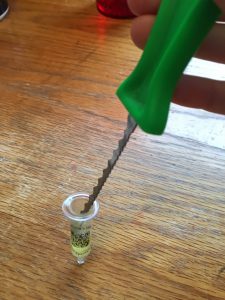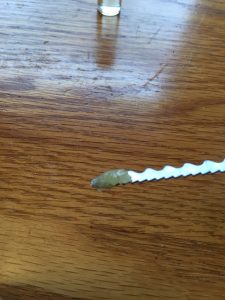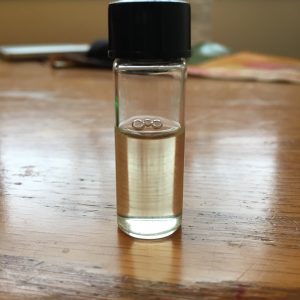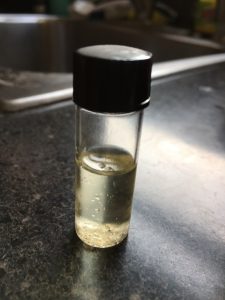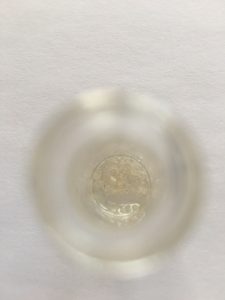Orion GMP Solutions Recognized as International GMP Compliance Firm
Last month an article in the Motley Fool highlighted the newly acquired EU GMP certification for Aurora Cannabis. With exportation of cannabis to European Union becoming increasingly popular, more LP’s are seeking to acquire this ceritification to expand beyond the Canadian market.
Orion GMP Solutions is one of the leading GMP compliance firms helping the cannabis industry go international. If your company is interested in EU GMP compliance or becoming one of the first companies in the US to be GMP compliant contact us at info@oriongmp.com. We offer free consultations to help you work towards international compliance or to simply adhere to your state and local guidelines. GMP compliance is complex and Orion GMP Solutions is here to help you every step of the way.
Growing CBD Crystals
Based on my lab experiences, I had an idea in mind for how I would purify CBD. Now it is time to put my ideas to the test!
Finding the Supplies
Having never done any chemistry outside of a university or industrial setting, I was completely unfamiliar with how to get supplies on my own. I was thinking of ordering solvents online, but by pure luck, I stumbled upon a vendor in downtown Ypsilanti, right off of Michigan Ave, while I was getting some takeout. Right as I was about to get in my car and drive home, I saw a storefront display with a bright blue solution in a beaker stirring. I was really curious, so I went inside to see what was going on. The store, ambiguously named Ypsilanti Oil Company, had a bunch of chemistry supplies and equiptment. Located across from the Ypsilanti Farmers Marketplace, they are an “Aromatherapy Service” company, the idea being that someone would buy herbs from the farmers market and then be able to get the supplies to go home and make their own extracts. I saw that they had hexanes, so I bought a one quart (946 mL) bottle for $42.40.
Excited about my spontaneous purchase and ready to try some things, I obtained 1 gram of a 70% CBD extract from a local “provisioning center” for $60, and ordered a 12 pack of 1 dram (3.7 mL) vials from Amazon for $7.
Step 1. Dissolve the CBD extract in hexanes
For a spatula, I used a knife from a pumpkin carving toolkit because it was narrow enough to fit into the CBD sample and also the vials.
I did not have a scale or syringes, but I would estimate that I dissolved approximately 200 mg of the CBD sample in 1.5-2 mL of hexanes. In other words, I filled the 1 dram vial half full with hexanes, and then added two “scoops” like the one shown above, which was about 1/5 of the 1g sample. I did not use any heat to dissolve the sample, just a bit of stirring for a few minutes with the knife, until the solution was homogenous and clear. I did notice that there were some “dirt” particles that did not dissolve, so if I were to do this again on a larger scale, I would probably add a filtration step before growing the crystals.
Step 2. Freeze Overnight
I put the vial, tightly capped, in my freezer overnight. 24 hours later, I found some clear crystals!
Step 3. Decant and Collect
I waited an additional 24 hours to see if I could get more crystal growth, but it looked about the same the next day. I then waited for the solution to warm up to ambient temperature and decanted off the excess solvent, leaving behind the crystal solids shown below. For the decanted liquid, or the mother liquor, I am evaporating to increase saturation and re-freezing to see if I can grow a second batch. I plan on testing the crystal samples along with the original one to determine the extent of purity improvement. Also, in the future, I will look into how to get the best yield and mass recovery.
Overall, I was able to grow some CBD crystals using only one solvent (hexanes) and without any heat.
Contact us at info@oriongmp.com to discuss how CannaChemist can help your organization refine chemistry processes.
California Cannabis Business Licensing – how we represent
Are you interested in having Orion GMP Solutions represent your California Cannabis Business? We’re here to help from applications to full implementation of Cannabis Good Manufacturing Practices.
Send us an email at info@oriongmp.com and get a conversation started today.
California Update – Review of the Final Emergency Regulations for Manufacturers
This past Thursday, the California Bureau of Cannabis Control (BCC) released their Emergency Regulations. This is an update to the drafts that were published earlier this year. After a public comment period, regulators revisited the documents and made a significant amount of changes. We sat down and thoroughly compared the draft regulations to the 99-page final emergency regulations and summarized them here. To review the full text of all the Emergency regulations that were just released, check out the California Cannabis Portal here. What are some of the BIGGEST changes?
- Fairly accommodating exemptions for microbusinesses
- Clear guidance for the transitional period (which could be up to 210 days), including exceptions from packaging and labeling as well as traceability requirements, making it much easier to continue operating legally while everyone gets their ducks in a row.
- Removal of Ethanol extractions from Type 7 licensing.
- Realistic inventory management reconciliation. The regulators finally smoked some of California’s finest and relaxed their daily requirement to something much more realistic, 30 days.
- Language providing leeway for companies affected by this year’s tragic fires.
- Protections of trade secrets.
Do you plan to be a microbusiness?
We have good news for you! Section 40101 (Applicability) provides exemptions for microbusiness manufacturers for the following sections:
- 40200 – Security Plan
- 40205 – Video surveillance
- 40282 – Inventory control
- 40290 – Waste Management
Will your company have an “owner” that is employed by any State agency that may have any duties related with enforcement of the Act?
A new section, 40116 “Personnel Prohibited from Holding Licenses” explicitly prohibits people holding office or employed by any agency of the State of California who may have duties related to enforcement of the Act from holding a license. This is a common sense regulation, and we applaud the state for including this language.
Temporary Licenses – The biggest unknown we have all been waiting for. Section 40126 lays out the process for obtaining a temporary license. Highlights include:
- Will be valid for 120-days, with the option for a 90-day extension upon submission of a complete application for licensure prior to the initial temporary license expiration date.
- Form is included at the end of the text.
Full Licenses – To be renewed annually
- Sections 40130 and 40131 lay the requirements out. This includes the definition of who an owner is. All “owners” are required to disclose additional information.
Priority Review Period
- Initially you had to prove you were in legal operation at the local level before January 1, 2016. This has been pushed back nine months to September 1, 2016 in order to be considered for priority review.
Application Fees
- No application fees are required to obtain a temporary license! This means, you have until you submit your application for full licensure to pony up the funds which are laid out below:
| Tier | Annual Gross Revenue | Fee |
| I | Up to $100,000 | $2,000 |
| II | $100,001 – $500,000 | $7,500 |
| III | $500,001 – $1,500,000 | $15,000 |
| IV | $1,500,001 – $3,000,000 | $25,000 |
| V | $3,000,001 – $5,000,000 | $35,000 |
| VI | $5,000,001 – $10,000,000 | $50,000 |
| VII | $10,000,001 – Ummm? | $75,000 |
Disaster Relief – New (Section 40182)
- Were you affected by the fires that ravaged Northern California? For better or worse, the state took this into consideration and has provided several provisions to allow you more time to become operational without jeopardizing your place in line.
Video Surveillance – More realistic
- Reduced frame requirements from 20 to 15 fps, reducing the upfront costs of equipment for you.
- Don’t forget, microbusinesses are exempt from video surveillance requirements.
- Increased minimum storage time for all recorded surveillance from 30 to 90 days. (Buy a bigger hard drive, they’re cheap)
Type 7 Licenses and Ethanol Extractors
- Ethanol is now a Type 6 license. However, it still requires approval by local fire code officials, which must be documented on your application.
- Type 7 licenses must also have their blessings from your local fire code official.
- Closed loop extractors must be approved by a licensed engineer from the State of California. Even though you may have purchased your product from an approved out of state vendor, you must have an engineer from California independently certify it.
Documentation
- The added language here is something we agree with, and is standard practice in most industries.
- Conduct Hazard Analyses and Preventative Controls based on the hazards. In addition to conducting these walk downs, written plans detailing them must be produced.
Protection of Trade Secrets
- Section 40262 clarifies that any protocols and documents that fall under the Master Manufacturing Protocol are considered “Trade Secrets” and do not need to be legally shared by anyone outside of the regulators and authorized personnel acting on behalf of state regulators for compliance purposes.
Processors of Juiced Beverages and Dried Meats
- Planning to infuse juice with THC or some cured jerky? Article 5 covers all the guidance you will need.
Inventory Control – Section 40282
- As mentioned at the top of the article, you will be required to reconcile your inventory every 30 days, not daily.
Cannabis Product Limits
- Adult use packages are limited to 1,000 mg of THC while medical use packages may contain up to 2,000 mg of THC.
Failed Batches?
- No need to risk having your entire batch destroyed because of a failed test. Section 40310 (formerly contaminants), allows you to remediate and/or reprocess your product up to two times before it must be destroyed due to failed testing.
Labeling and Marketing Requirements
- This one is too large to cover adequately. There are a lot of things to consider, including how you word any potential health-related statements to placement of the new cannabis symbol. For assistance making sure you are not at risk of license revocation because of an unfounded claim, contact us to put you in touch with one of our preferred cannabis law firms.
Transitional Period – Exemptions
- Shared facilities – The state has not figured out how to manage shared facilities (facilities that produce or sell both medicinal and recreational products). Because of this, they are allowing M and A facilities to conduct activities with each other until July 1, 2018 (Subchapter 7 – Transitional Period). Hopefully by then, the state will have filled in additional guidance on how to allow companies to offer both products under the same space.
- Track and Trace system – During the period of time you hold a temporary license (up to 210 days), you will not be required to comply with the track and trace system (Section 41515).
- Packaging and Labeling – Products produced prior to January 1, 2018 will still be allowed to be sold, regardless of whether they meet the new enhanced packaging and labelling requirements.
Contact Us.
Orion GMP Solutions is a Pharmaceutical Process Engineering firm based out of Denver Colorado. We specialize in the implementation and auditing of GMP Cannabis Manufacturers to assist them in reaching international markets. If you would like to get more information, please send us an email at info@oriongmp.com.
This content was written and supported by Orion GMP Solutions.
Cannabis Marketing 101 and FDA 483 Warning Letters
Last week, the FDA sent out 483 Warning Letters to four cannabis manufacturers. This brings the total to 44 letters since 2015, and serves as a clear reminder that the Feds are watching. Today’s post seeks to answer these common questions: What is a 483 Letter, What are the implications, and What can I do to avoid receiving a letter?
Background
There is anecdotal evidence everywhere you look regarding the new elixir of life, a still registered schedule 1 drug substance, reports of how the cannabinoids have treated a myriad of ailments from Crohn’s and PTSD to epilepsy. While scientific evidence is beginning to surface in support of these anecdotal reports, they have not undergone the full gamut of investigations for new drug trials (INDs) as required by the FDA. As a cultivator, manufacturer, or dispensary that is trying to differentiate your brand(s) in this rapidly growing and competitive market, highlighting how your proprietary strain may offer relief from all sorts of ailments has become the hallmark of Cannabis Marketing 101. Seller beware, words have meaning, and despite the continued classification of cannabis as a Schedule I drug in the United States, you better believe the FDA is watching closely. While the Cole memo has restrained Federal agencies from interfering with state run programs, it does not however, prevent them from investigating and acting on producers that make unsubstantiated therapeutic claims about their products, which is in direct violation of the Federal Food, Drug and Cosmetic (FD&C) Act, and may put patients at undue risk.
What is a 483 Warning Letter?
Unless the FDA has specifically approved a drug for use related to a disease or ailment, marketing it as so is a clear violation of the FD&C Act and may prompt the issuance of a 483 Warning Letter.
What are the implications?
This letter addresses any violations of the Act, and you are given 15 working days to respond to the FDA addressing how you have mitigated any and all of the violations. Failure to respond and address the issues in a timely manner will result in further Administrative and potential legal action.
What Can I do to avoid receiving a letter?
There are a few simple tips that, if followed, will allow you to strategically market your products without risk of receiving a friendly letter from the FDA.
- You know that fine print that no one can read at the bottom of just about every commercial on TV? It’s there for a reason. At the bottom of every piece of marketing material that may allude to cannabis derived compounds aiding in remedies, include the words “These statements have not been evaluated or approved by the Food and Drug Administration. This product is not intended to diagnose, treat, cure, or prevent any disease.”
- Furthermore, refrain from using the phrase “Studies have shown…” or anything that could be misconstrued as such, unless you are 100% confident that you can and are willing to testify to back up your claim in a court of law. It’s just not worth it.
- Implement current Good Manufacturing Practices (cGMPs). While not specifically required by individual states (with the exception of California it appears), having a quality plan, and good batch control (essentials to cGMPs) ensure you are able to verify presence and concentration of constituents you claim are present. Know and trust the lab you are obtaining your results from. Verify that they have certified calibrations, and MDL (Method Detection Limit) studies as well as appropriate batch QC (Quality Control) samples that can document with high confidence the results are valid.
By following these simple rules, you will avoid making it on the FDAs radar, reduce your probability of product recalls and continue to build confidence and brand loyalty within your consumer base.
Contact Us.
Orion GMP Solutions is a Pharmaceutical Process Engineering firm based out of Denver Colorado. We specialize in the implementation and auditing of GMP Cannabis Manufacturers to assist them in reaching international markets. If you would like to get more information, please send us an email at info@oriongmp.com.
This content was written and supported by Orion GMP Solutions.
Bisiani – “A Therapeutic Alternative…”
When we meet people that are moving the cannabis industry in the right direction, we take note and listen up. We’ve written on Ms. Bisiani before, and she continues to write more content. She has a focus on older populations, and this time she has written about medical cannabis as an alternative for management of chronic pain in older Australians.
Medicinal Cannabis: A Therapeutic Alternative for Management of Chronic Pain in older Australians
Our thoughts:
Mainstream pharmaceutical drugs are accepted because they have clinical trials to back up their efficacy, but alternatives do not have the same evidence. There is, however, significant anecdotal evidence to suggest efficacy of cannabis in pain management. We think the most immediate solution, is publicly funded backing for clinical trials.
Opiates cause harm, have high risks of dependence, and cause downstream public health issues. People die from opiate overdose, and the withdrawal symptoms are reported to be extreme. When comparing the factors of addiction and health risks between opiates and cannabis, it becomes difficult to ignore cannabis as an option.
We agree that reproducible formulas are key to moving cannabinoid therapies forward. But, again, under a clinical setting. Right now, cannabis products have significant variation between different cultivation sites, and this leads to higher variation. As a result, patients have to hope the products they consume will be consistent batch-to-batch. Data presented by Dr. Meiri from the Technion suggests that variation in cultivation environment causes variation in the cannabis plant’s cannabinoid expression profile, that then, with certainty, changes the therapeutic outcome. This doesn’t even account for the multiple different ways of administering cannabis, and variation in the manufacturing processes of those (extract) products.
We also agree on healthcare provider education, but I think they are at a loss without the clinical evidence. I have spoken with doctors who recommend cannabis, but they are hesitant to prescribe it. They don’t have the clinical data that they rely on to make decisions. This is why Germany is going through a “clinical preparations” route for providing cannabis to those who could benefit from its therapeutic use.
Again, this circles around to the need publicly funded basic research and then clinical trials in order to properly educate health care practitioners. For now, they have to rely on direct observation of patients and the anecdotal evidence they gather through experience. Monitoring patients cannabis use will be the key for future clinical studies, and health care professionals collaborating will be the best first step for the therapeutic benefits to be validated.
Lessons from CannaTech UK 2017
CannaTech is a high intensity event. The stakeholders are made up of high quality groups that provide amazing knowledge and networking opportunities. The presentations are geared towards a clinical approach to medical cannabis and the importance of developing intellectual property for building long term solutions that improve patient health outcomes. CannaTech makes the industry a smaller place by bringing together the best of health science, current clinical research, business developments, and networking opportunities for the cannaceutical industry.
Cannabis is in clinical trials.
There are many products that are in clinical trials in Israel, and Tracy Ryan, the CEO of CannaKids described her pathway towards becoming an advocate of clinical trials for CannaKids products. Companies like hers are developing products that may have the potential to treat specific types of disease, but must be proven in clinical studies to transform anecdotal evidence into clinically proven evidence based medications. It is a huge step in the right direction as statistically relevant studies are needed to prove the efficacy of cannabis against the claims made by companies concerned about product liability.
Smoke can be liquid… or at least can be made water soluble.
Dr. William Levine described the state of clinical research for the Ci therapeutics and iCansleep product. He made the relative comparisons from their research showing how their proprietary formulations can both decrease sleep onset latency and total sleep duration. Their partnership with iCan is backed on a proprietary cannabis combustion system that combusts raw plant materials and condenses them for recovery and compounding into their formulations. Finally, they have an FDA approved nebulizer that completes the whole package. If there was one company I would pay royalties to use their IP, it is Ci therapeutics and iCansleep.
Distribution will be the central point of activity in California.
Alcohol distribution is a tried and true model. Alcohol distributors pick up brands that they can qualify for meeting quality specifications and requirements, and then distribute the brands through their networks of buyers. This will change the face of cannabis distribution, and will likely a major taxation hub within the industry. There is much talk around block chain enabled software platforms to track and trace all transactions.
Ancillary businesses are the best investment.
It is not easy being a manufacturer of GMP Cannabis, or recreational cannabis, for that matter. The risks associated with manufacturing are huge, and it is a fact that commoditization (see below) of cannabis will continue to drive wholesale prices down. Ancillary business, should expect growth as manufacturing competition forces the market to adopt lean processes and eliminate waste. This provides endless opportunities for entrepreneurs to find ways to help manufacturers improve their bottom line.
Cannabis is a commodity.
Arcview market research paints the this point in one simple diagram. Cannabis wholesale prices are compared to spinach wholesale prices. This clearly describes the situation observed in cannabis micro-economies, such as Colorado and Washington states, where prices continue to decline. If businesses are not implementing lean manufacturing strategies and planning for the long term, they will likely struggle to compete in the future.
Networking.
There are hundreds of people and firms that show up to CannaTech events, and the crowd is filled with people who understand cannabis, the science behind it, clinical studies, and Good Manufacturing Practices. They are the representatives of the medical cannabis community, which is being coined as the cannaceutical community. They are groups that are looking for clinical evidence of cannabinoid therapies, and their seriousness is evident in the content of their conversations.
Conclusion.
CannaTech is the place for networking regardless of its location. It’s not a trade show, it’s a conference where investors are exposed to the latest advancements in cannabis. Sessions on cannabis science, Good Manufacturing Practices, and sound intellectual property investments evoke conversations and networking that leads to international opportunities. It encourages collaboration and embodies what I’ve gathered to be, the Israeli entrepreneurial spirit. All that said, I look forward for the opportunities to come from attending CannaTech in Tel-Aviv.
Medicine Man Technologies Secures a German Tender Client and Establishes a Relationship with Orion GMP Solutions
Orion GMP Solutions and Hemp Hacker are very proud to establish a working relationship with Medicine Man Technologies. Medicine Man Technologies is a quality manufacturing consulting group that specializes in assisting its clients become legal and compliant manufacturers of GMP Cannabis.
Orion GMP Solutions is a Pharmaceutical Process Engineering firm based out of Detroit Michigan. We specialize in the implementation and auditing of GMP Cannabis Manufacturers to assist them in reaching international markets. If you would like to get more information, please send us an email at info@oriongmp.com.
This content was written and supported by Orion GMP Solutions.
Chronic pain in the aged care setting
Medicinal Cannabis: A Therapeutic Alternative for Management of Chronic Pain in older Australians:
Presented by:
Leah Bisiani
MHlthSc/Dementia Consultant/RN.1.
“United in Compassion Symposium”, Melbourne, Australia. June 2017
“Consider the present alternative, which is, we continue ignoring the significant benefits of cannabis, and refuse to contemplate the areas where traditional medicine is ineffectively managing critical conditions. We must provide a united front in advocating for medicinal cannabis as an innovative solution and a way forward within the realms of modern medicine by challenging and dispelling the myths and attitudes associated with cannabis, and sharing what we have recognized as the beneficial attributes associated with this plant”
Highlights:
Our commitment is to put the focus back on patients. Leah’s motivation regarding the emerging medicinal cannabis industry is to “challenge stigmas that have been propagated by judgmental perspectives of society related to negative stereotypical views, of which do not reflect the reality of the people we care for.”
Philosophy of Empathy and Compassion:
“Those who work within the medical and caregiving communities generally enter the health profession because of a belief in the alleviation of suffering for humanity. We aim to speak with empathy and compassion from the perspective of those who deserve to live a life free of suffering. Let us advocate for more empathetic approaches that will benefit our population, alleviate suffering, and maximize dignity, value, and quality of life. It is our responsibility to benefit our people, and to provide them with answers to identified problems and conditions, even and especially when these conditions do not respond to available medicine or practices.” Bisiani’s work is in “innovative approaches, thinking outside the box, and creating change, through the courage of our convictions. Actually, what I truly believe is there is no box,” says Bisiani.
Education is crucial:
Bisiani characterizes the situation well: “It’s real, it’s positive, it’s logical, and it’s humane. All change takes time, because making dreams a reality and anything worth fighting for, requires effort. Let us continue encouraging a solid and robust duty of care, that should be, at the very least, a baseline expectation within our medical community. We are creating a framework that enables current information for prescribers, patients, and society. We can reverse the stigma, and make it clear we are advocating exclusively for medicine through clinical based research, providing data and evidence for medicinal cannabis as a therapeutic alternative to non-effective regimes. Once provided, there will be a responsibility to honor these results or else be accused of denying assistance and permitting ongoing suffering and anguish. A multidisciplinary approach is required to enable an overall treatment plan to compliment the use of medical cannabis. Considerations of age, nutrition, environmental factors, lifestyle, can all be adjusted to maximize life quality first and foremost. Balance is what we aim for.”
The current landscape of pain in aged care:
“Pain is a fundamental and universal human experience, and thus access to effective pain relief should be regarded as an essential and universal human right. With the influx of baby boomers into the aged care community and an increase in life expectancy of our population, there is a growing need for more effective pain management regimes. Opioid analgesics are widely prescribed currently, yet these agents are associated with the highest degree of drug-related harm. The frequent and significantly dangerous adverse effects associated with opioids are detrimental to living safely, as they often predominantly affect mood, conscious thought, judgement, can create hallucinations and delusions, change cognition, and affect mobility. In relation to people living with dementia, these regimens can exacerbate the symptoms of dementia and potentially place them at higher risk of complications. Another huge issue regarding people living with dementia is that they may be unable to verbally express their pain. People living with dementia feel pain just as acutely as we do, and it is our responsibility to ensure their pain is managed, to avoid catastrophic events associated with acute delirium, behavioral expression and increased debility. It has been indicated that many geriatrics prescribed opioid pain management regimes are still not having their pain effectively managed. There is an urgent need for an alternative approach.”
An available solution:
The potential benefits of medicinal cannabis in treating poorly managed intractable chronic pain has been suggested as a beneficial alternative approach to enhancing quality of life and maximizing comfort and well-being in Australia’s older population. We are the ones with the drive and ability, so that we may revolutionize modern medicine in a way that creates a sustainable future for those in need. We are moving forward, and are fighting for what is right because we care on a level that is inundated with true compassion.

